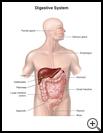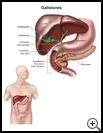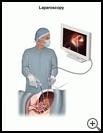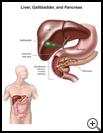
Gallstones
What are gallstones?
Gallstones are hard stone-like objects that build up in your gallbladder. They may be as small as a grain of sand to as large as a golf ball.
The liver, gallbladder, and pancreas are part of your digestive system. The liver makes bile that helps your body break down the fat in food. Ducts carry bile from the liver to the gallbladder and the small intestines. The gallbladder is a small sac under your liver on your right side that stores bile. The pancreas makes fluid that helps break down food. A duct carries digestive fluids from the pancreas to the upper part of your small intestines.
Gallstones may stay in the gallbladder or smaller stones may move into the bile ducts. It's possible for stones to move into the main bile duct and block it. If the bile flow from the gallbladder is blocked, the gallbladder can become inflamed and infected. This condition is called cholecystitis. If the bile backs up in the liver, it can cause your skin and white part of your eyes to turn yellow (jaundice). Gallstones can also cause inflammation in the pancreas (pancreatitis) that can be life threatening.
You are more likely to have gallstones if:
- You are female
- You are pregnant, are on hormone replacement therapy, or take birth control pills
- You are overweight
- You have type 2 diabetes
- You are Native American
- You have sickle cell anemia or another disease that breaks down red blood cells
- Other members of your family have had gallstones
What can I expect in the hospital?
Several things may be done while you are in the hospital to monitor, test, and treat your condition. They may include:
Monitoring
- You will be checked often by the hospital staff.
- Your heart rate, blood pressure, and temperature will be checked regularly.
Testing
Testing may include:
- Blood tests to check for infection and liver function
- Tests to look for abnormalities in the gallbladder and bile ducts, which may include:
- Ultrasound scan: Sound waves and their echoes are passed through the body from a small device that is held against your skin to create pictures of the inside of the liver, gallbladder, and bile ducts belly, including the liver, gallbladder, bile ducts, and intestines.
- Nuclear gallbladder (HIDA or DISIDA) scan: A test in which a radioactive chemical is injected into your bloodstream and pictures are taken with a special camera (called a gamma camera) to see if the gallbladder or bile ducts are blocked or swollen
- Endoscopic retrograde cholangiopancreatography (ERCP): A test in which a slim, lighted tube with a camera is passed through the stomach and into the small intestine and bile duct to check for stones or blockages
- Computed tomography (CT) scan: A series of X-rays is taken from different angles and arranged by a computer to show thin cross sections of the liver, gallbladder, and bile ducts.
- Magnetic resonance cholangiopancreatography (MRCP): A nuclear medicine study to see if you have gallstones and where they are located
Treatment
The treatment for gallstones depends on how severe your gallstones are, if there is a blockage or complication, and your general health. Treatment may include:
- You will have a small tube (IV catheter) inserted into a vein in your hand or arm. This will allow for medicine to be given into your blood system and to give you fluids, if needed.
- You may have a procedure called endoscopic retrograde cholangiopancreatography (ERCP). ERCP is a procedure in which a thin, lighted tube with a camera (called an endoscope) is passed through the stomach and into the small intestine and bile duct to check for stones or blockages. ERCP may be used in combination with a laparoscopic surgery to enlarge the opening from the common bile duct into the intestine. It may then be possible to remove the stones or allow them to pass through the enlarged opening. This may be done before or after surgery to remove the gallbladder.
- If your gallstones cause severe pain or a blockage you may need surgery to remove the gallbladder, called a cholecystectomy. The type of surgery you have to remove the gallbladder may be one of the following:
- Open cholecystectomy (laparotomy): Surgery to remove the gallbladder and part of the tube from the gallbladder to the common bile duct through one larger cut in your upper belly
- Laparoscopic cholecystectomy: Surgery to remove the gallbladder through several small cuts in the upper belly. Your healthcare provider inserts a thin, lighted tube with a camera (called a laparoscope) through the cut and into your belly to help see and remove the gallbladder.
- You may have a procedure called extracorporeal shockwave lithotripsy (ESWL). This procedure uses sound waves to break up the gallstones.
- Your provider may prescribe medicine to:
- Treat pain
- Treat or prevent an infection
- Treat or prevent side effects, such as nausea or constipation, from other treatments
- Dissolve gallstones
- Your provider may recommend other types of therapy to help relieve pain, other symptoms, or side effects of treatment.
What can I do to help?
- You will need to tell your healthcare team if you have new or worsening:
- Bloating or belly pain
- Nausea or vomiting
- Yellow skin or eyes.
- Light colored bowel movements
- Dark urine
- Redness, swelling, pain, warmth, or drainage from your surgical wound
- Fever, chills, or muscle aches
- Ask questions about any medicine or treatment or information that you do not understand.
How long will I be in the hospital?
How long you stay in the hospital depends on many things, such as your general health, why you are in the hospital, and the treatment you need. The average amount of time to stay in the hospital for gallstones is 3 to 5 days. Talk with your provider about how long your stay may be.
Last modified: 2016-03-30
Last reviewed: 2015-10-07




